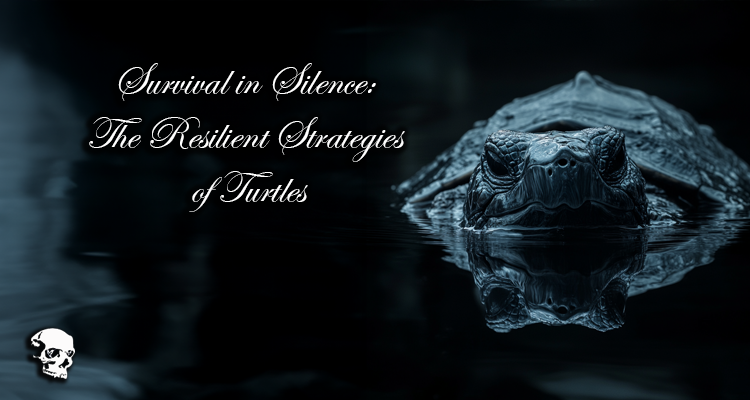Currently Empty: $0.00

Survival in Silence: The Resilient Strategies of Turtles
Turtles, ancient creatures that have traversed the Earth for over 200 million years, possess a remarkable array of survival strategies. These creatures, often associated with endurance and resilience, have developed complex defenses through millions of years of evolution. This article explores the subtle yet powerful survival strategies of turtles, highlighting their behavioral, morphological, and physiological adaptations.
Behavioral Strategies: The Power of Stillness
In the quiet corners of freshwater habitats, turtles like Emys orbicularis and Mauremys leprosa have mastered the art of stillness. When faced with danger, their instinct is to withdraw, minimizing movement and blending into their surroundings. This ability to remain motionless, often buried in mud or nestled among vegetation, is a crucial tactic for avoiding predators.
What’s fascinating is the individuality in these responses. While some turtles may opt to flee, others rely on their camouflage and stillness, trusting that invisibility will keep them safe. This variability in behavior reflects the complexity of turtle survival strategies, where each decision is a matter of life and death. In environments where even the slightest motion can attract attention, remaining still becomes a powerful form of defense.
Morphological Defenses: The Shield of Endurance
A turtle’s shell is its most iconic and vital defense, a natural shield that has been fine-tuned over millennia. For terrestrial turtles, the shell’s dome shape serves multiple purposes: it not only protects against predators but also aids in self-righting if the turtle is flipped onto its back. This ability to correct its position is critical, as being overturned can leave a turtle vulnerable to attacks.
The shell also represents a story of growth. Juvenile turtles, in their early and vulnerable stages, develop spines and widen their carapaces to deter predators. As they mature, these features evolve; spines recede, and the shell hardens, becoming a more effective barrier against threats. The shell’s evolution showcases the turtle’s long journey towards survival, embodying their slow but persistent adaptation to the challenges of their environment.
Physiological Adaptations: Survival in Extremes
Beyond physical defenses, turtles have developed unique physiological adaptations that allow them to survive in extreme conditions. One of the most extraordinary is metabolic depression, a state where turtles can drastically reduce their metabolic rate to conserve energy. This is particularly useful during hibernation or in environments with low oxygen, such as underwater.
In this state, turtles enter a near-suspended animation, where their heart rate slows, and their body temperature drops. This adaptation enables them to endure prolonged periods of inactivity, surviving in conditions where others might not. It is a powerful reminder of the turtle’s resilience, their ability to endure in the harshest environments through finely tuned physiological responses.
Active Defense Mechanisms: The Bite of Defense
While turtles are often seen as passive creatures, they are not without more aggressive means of protection. Biting is one such defense, especially prevalent in smaller turtles. When hiding or escaping is not an option, these turtles may resort to biting as a deterrent to predators. As they grow larger, however, their strategy shifts. Larger turtles often rely more on their shells, retreating into them to present a tough, impenetrable surface.
This shift from active to passive defense as turtles mature highlights the adaptability of their survival strategies. In their youth, when they are more vulnerable, biting serves as a necessary means of protection. But as they age, the emphasis shifts towards relying on their hardened shells, signifying a transition from vulnerability to resilience.
Ambush Tactics: The Silent Predator
Not all turtles are purely defensive; some species have developed sophisticated predatory tactics. The Matamata turtle (Chelus fimbriatus) exemplifies this with its unique ambush strategy. Its camouflaged appearance allows it to blend seamlessly with its environment, resembling dead leaves and debris. The Matamata lies motionless, waiting for unsuspecting prey to come close. When the moment is right, it strikes with a swift, precise lunge.
This ambush behavior is a calculated survival strategy, where patience and precision are key. The Matamata’s approach reflects an intricate understanding of its environment, where being unnoticed is essential for both hunting and survival. This strategy underscores the dual nature of survival in the wild, where even the most passive-seeming creatures can become effective predators.
The Legacy of Survival: Strength in Stillness
The survival strategies of turtles are a testament to their enduring resilience. From their behavioral tactics of stillness to the formidable protection of their shells, and the physiological marvel of metabolic depression, turtles have developed a complex web of defenses that ensure their survival in a world filled with threats.
These strategies are not merely about survival; they represent a profound connection to the natural world, a bond that has allowed turtles to thrive across countless generations. Their slow, deliberate movements and ability to endure in the face of adversity highlight a strength that resonates with those who appreciate the quiet power of endurance. As we explore these survival strategies, we are reminded that true resilience lies not in aggression but in the ability to adapt, endure, and find strength in even the most challenging circumstances.
Are you enjoying this article or our site? Love of Gothic and the Dark Matters & Mischief magazine are run by dedicated volunteers, and we rely on crowdfunding to cover our expenses. Your support is crucial to keep us going! Consider becoming a paying member of our Patreon or purchasing something from our shop to help us continue providing content and community support. Thank you for your support!

